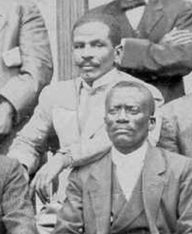
Memorias de un simposio, Ginebra, Suiza,
1912-2012, Aline Helg, ed
Estenoz
Autopsy - full screen
Photo Gallery on the Autopsy
Hablando con Evaristo Estenoz, 6/2011, Raúl Ramos Cárdenas: resacate de una entrevista con Evaristo Estenoz
en 1910
The 1912
Massacre
Partido de los Independientes de
Color
The Mambi Army
Cuban History Time Line
Roots of My Heart, a new film by
Gloria Rolando on 1912
Links |
 Evaristo Estenoz Corominas Evaristo Estenoz Corominas
"Adorela como Martí!" - Arsenio Rodriguez
Evaristo Estenoz (left, surrounded by party members) was a founder of the Partido de los Independientes de
Color, the
Independents of Color, the first independent black political party in the
hemisphere.
The Independientes de Color was founded in 1908 in Havana by Evaristo Estenoz,
Pedro Ivonet, journalist Gregorio Surín, and a group of followers many of whom
were veterans of the Mambi Army (80% - 90% black). Estenoz himself had been
an aide to General Quintín Bandera, who was
killed on the orders of president Estrada Palma, much as Estenoz was killed on
the orders of president Miguel Gomez.
Los Independientes wanted their rightful
share after winning the wars against Spain for the independence of Cuba (1868-1878 and
1895-1898). For that presumption, the Cuban Army massacred over 6,000 of them in
1912. Estenoz was among those killed - he was "shot point blank"
in the back of the head. We present a photograph
in evidence with the medical desecrators of his body showing off the wound on the back of
his head surrounded by army officers, perhaps those who killed him and brought him in. massacred over 6,000 of them in
1912. Estenoz was among those killed - he was "shot point blank"
in the back of the head. We present a photograph
in evidence with the medical desecrators of his body showing off the wound on the back of
his head surrounded by army officers, perhaps those who killed him and brought him in.
In 1908, the date of the founding of the Party, José Miguel Gómez was elected
President of Cuba. In 1909, the US ended its second U.S. military occupation of Cuba.
The AfroCuban integrationist Martin Morúa Delgado was elected speaker of the Cuban
Senate. In 1910, Morúa proposed a law, the Morúa Amendment, which passed and banned the
Independiente de Color as a political party because it was said to be based on race.
He argued that since African born Cubans had been given citizenship and could vote, racial
privileges had disappeared and a party based on color was unconstitutional. He was
supported in this by the miguelista newpaper El Triunfo which initiated the strong
anti-black line that the Independientes were rapists favoring a Haitian style revolution.
Morúa died days after being named minister of agriculture. In the midst of the repression
of the Partido Independiente de Color, he was given a state funeral to show blacks that
those who were integrationists were acceptable. Also in 1910, there was widespread
repression of blacks, even those not in the Independientes de Color, but for example in
the Sociedades de Color. There was a purge of blacks from the security forces.
Finally, in 1912, the Cuban Army did a search and destroy on the Independents of Color,
massacring over 6,000 and effectively killing the dream. The repression was severe and
extended far beyond the Party - for example, the Villamil of
Matanzas had to hide their drums in certain wells.
"Adorela como Martí!" -- Arsenio Rodriguez, singing of the
leaders of the liberation army and the Independents of Color, while having
to disguise what he was doing by using the feminine singular. Or maybe he
was referring to "la jefetura!" |



